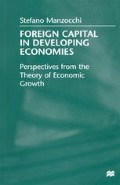Abstract
This chapter deals with the long-run effects of international capital flows from the perspective of growth theory. Our main concern is with the impact of capital flows on growth and ‘convergence’, a concept which is variously defined according to the underlying theoretical framework; as in Chapter 3 we outline different models that are of general relevance, but we then apply them to the case of developing economies. As we focus on the long run, the use of external capital as an instrument for consumption-smoothing is neglected. However, while in Sections 4.1 and 4.2 we rule out the possibility that a country mortgages a constant stream of future (per capita) income to increase current consumption, this possibility is allowed for in the model of Section 4.3. This enriches the range of feasible outcomes stemming from integration in world capital markets.
Access this chapter
Tax calculation will be finalised at checkout
Purchases are for personal use only
Preview
Unable to display preview. Download preview PDF.
Notes and References
This distinction holds within the concept of ‘convergence in income levels’ (the so-called beta-convergence); we are neglecting the concept of ‘reduced dispersion of income levels’ (the so-called sigma-convergence). See Barro and Sala-i-Martin (1995, pp. 26-31). On the evidence against absolute convergence, see Pritchett (1997).
Recall that for the sake of simplicity we set the rate of exogenous technical progress equal to zero as in Chapter 3.
See the Appendix (p. 75).
What are the consequences for DCs of capital mobility in models of endogenous growth? Provided the pattern of net flows depends on the assumptions of the model — namely, there is no guarantee that DCs are net capital importers — if capital mobility implies a lower rate of interest in DCs this leads to a higher rate of sustained growth (see, for instance, Lucas, 1988, p. 23; Eaton, 1993, p. 143-8). Of course there is no ‘convergence’ in the sense intended here as there is no steady state in models such as those of Section 3.2.
The existence of three ‘growth clubs’ consisting of high-, middle-and low-income countries was suggested by Baumol (1986); see also Abramovitz (1986).
See Chenery and Syrquin (1986, pp. 68-73); Dowrick and Gemmel (1991, p. 273). For a comprehensive survey of growth accounting techniques and TFP estimates, see Maddison (1987).
A list of such’ stylised facts’ of growth is provided by Romer (1989).
This sort of structural instability is modelled by Azariadis and Drazen (1990); Spiegel (1995).
See Cho (1990a).
See Cooper and John (1988, p. 442) for a definition of ‘coordination failures’.
Rodrik (1996b) develops a more detailed closed-economy model of economic transformation in the presence of coordination failures.
A third case, in which (1/1 + ρ)[p − 1] > γ is rather trivial, as moving into the modern sector in period 2 is the dominant strategy for each worker.
One can easily check this statement substituting for l2 in (4.20b), and taking account of condition (4.22). If exactly fellow-workers enter the modern sector in period 2, a worker is indifferent between choosing strategy T or M.
Cooper and John (1988, p. 444).
Cooper and John (1988, p. 448).
This intertemporal ‘bottleneck’ is determined by condition (4.21).
This is true only of foreign borrowing, while direct investment from abroad could play an active role in the process of industrialization provided it has a ‘dimension’ sufficient to overcome the coordination gap: I am grateful to Giuseppe Bertola for raising this issue. Rodriguez-Clare (1996) provides a model in which multinationals can overcome underdevelopment traps due to increasing-returns technologies.
Recall that γ and θ are positive by assumption.
The solvency condition is fulfilled by assumption in this section, but could be violated in reality.
Rosenstein Rodan (1943, p. 249).
Of course, a model that incorporates such a market structure can differ on many other relevant points from the present one.
Scitovsky (1954, p. 306).
Taylor’s theorem is summarised in elementary mathematical textbooks. See also Barro and Sala-i-Martin (1995, pp. 513-14).
Author information
Authors and Affiliations
Copyright information
© 1999 Stefano Manzocchi
About this chapter
Cite this chapter
Manzocchi, S. (1999). Growth Theory and the Effects of Capital Flows. In: Foreign Capital in Developing Economies. Palgrave Macmillan, London. https://doi.org/10.1007/978-1-349-27620-2_4
Download citation
DOI: https://doi.org/10.1007/978-1-349-27620-2_4
Publisher Name: Palgrave Macmillan, London
Print ISBN: 978-1-349-27622-6
Online ISBN: 978-1-349-27620-2
eBook Packages: Palgrave Economics & Finance CollectionEconomics and Finance (R0)

